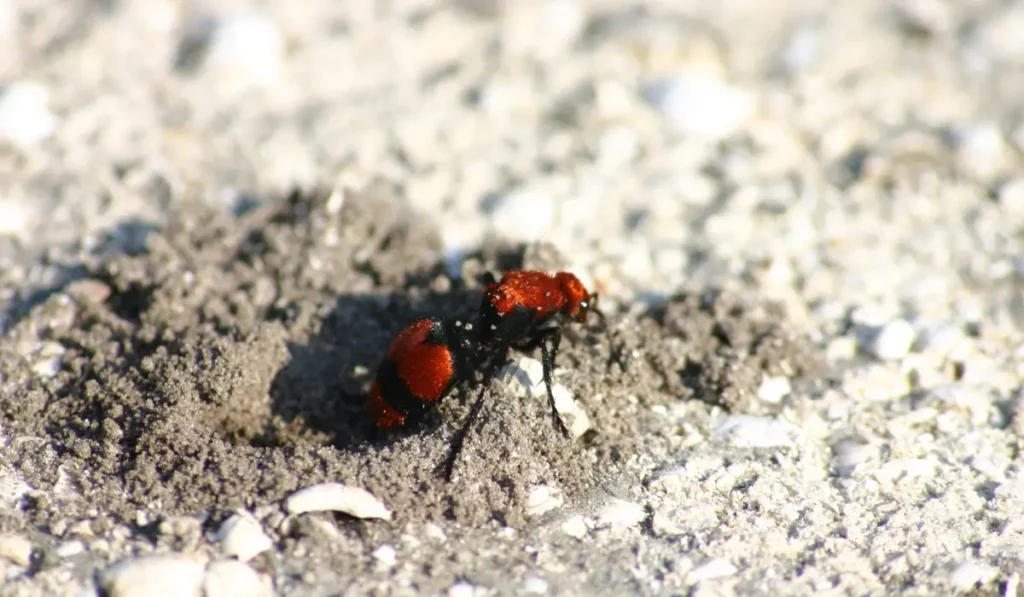Have you seen an insect with a bright red exoskeleton on your lawn? Be alert – it might be the well-known Cow Killer Ant. This ant’s name seems like a bold claim, but its sting is indeed harsh.
In this piece, we’ll cover all you need to know about Texas’s Cow Killer Ant, from what it looks like to where it lives and the best ways to keep it away.
Key Takeaways
- Female Cow Killer Ants are known for their sharp sting. Though it hurts, they usually don’t harm people unless bothered.
- These ants are hard to get rid of due to their lone habits, living underground, strong shells, and ability to live in many climates.
- To control Cow Killer Ant problems, opt for insecticides made for this task and seek help from pest control pros. Changing your yard’s layout can also help keep them away.
What Is Texas’s Cow Killer Ant?

Description
Cow Killer Ants (dasymutilla occidentalis), commonly referred to as Velvet or Red Velvet Ants, are actually wingless wasps belonging to the Mutillidae family. These unique insects are found throughout various parts of the United States, Texas being a notable habitat.
Characteristics include:
- Red exoskeleton with fine hairs
- Females are larger and more visible than males
- Females possess a stinger on their abdomen, used primarily for defense
Habitat
Contrary to their name, Cow Killer Ants aren’t known to attack cows. They favor sandy areas in gardens and lawns with sparse ground cover.
The wingless females are often seen roaming for nests belonging to ground-nesting bees or solitary wasps. They lay their eggs in these nests, providing a reliable food source for their young.
The early life stage of Cow Killer Ants is parasitic; the hatching larvae feed on the host larvae, leading to the latter’s demise.
Male Cow Killer Ants, equipped with wings, are typically seen flying in search of mates. Despite their daunting name and potent sting, these ants are not naturally aggressive and will only react if disturbed.
Sting
Cow Killer Ants are infamous for their painful sting, which gives them the dramatic name “Cow Killer.” This name is an exaggeration, as these insects don’t actually kill cows. However, the sting is very painful!
The females are responsible for this notorious sting. Their stinger, found on the abdomen, is longer and more potent than those of many other wasp species.
The intensity of their sting is often rated between 3 and 4 on the Schmidt Pain Index, which categorizes the pain level of various insect stings. To put this in perspective, a Honey Bee is rated a 2 on the pain scale.
So while the Cow Killer Ant’s sting can be daunting, it’s usually not life-threatening to humans or larger animals, with the exception of allergic reactions.
Are Cow Killer Ants Dangerous?
Cow Killer Ants can be a menace to other insects but aren’t usually a threat to humans unless they feel threatened.
While their sting is notably painful, it’s rarely life-threatening. However, people with allergies to insect stings should be cautious, as they might have severe reactions and need immediate medical care if stung.
If you spot these ants in large numbers on your property, it’s wise to call in professional pest control services. Handling them without the right know-how and safety gear could result in unwanted stings.
Why Are Cow Killer Ants So Hard to Kill?
Cow Killer Ants are known for being tough to exterminate, and there are several key reasons:
- Solitary Lifestyle: Female Cow Killer Ants, which you’re more likely to see, are lone wanderers. Since they don’t gather in large groups, complete removal can be challenging.
- Underground Habitats: They often choose underground spots, like nests of ground-nesting bees or solitary wasps, as their homes. This habitat choice makes them harder to reach.
- Strong Exoskeleton: Their exoskeleton is tough, providing excellent defense against physical harm, potential predators, and many insecticides.
- Climate Resilience: These ants are adaptable to various climates, allowing them to thrive in different environments.
How to Get Rid of Cow Killer Ants
Tackling Cow Killer Ants on your property demands a well-thought-out strategy due to their toughness. Aside from conventional prevention strategies, consider these methods for control:
- Insecticides: While their robust exoskeleton shields Cow Killer Ants from many insecticides, specific specialized formulas are effective. Opt for broad-spectrum insecticides labeled explicitly for wasp control.
- Professional Pest Control Assistance: Given the complexities of handling Cow Killer Ants, enlisting professional pest control services is often the best course of action.
- Landscaping Adjustments: Since these ants favor sandy spaces or areas with minimal vegetation, altering your landscaping can deter them. Introducing dense mulch or ground cover plants can help minimize exposed sandy patches, making your property less inviting to them.
Remember that these approaches require patience and consistency. They’re not instant solutions. Professional pest control services are a safer bet if in doubt and can ensure peace of mind and the best results.